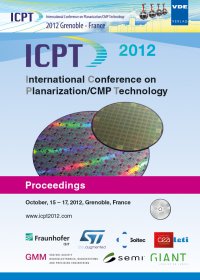Determination of Adhesion Force of Particles on Substrate Surface using Atomic Force Microscopy
Conference: ICPT 2012 - International Conference on Planarization / CMP Technology
10/15/2012 - 10/17/2012 at Grenoble, France
Proceedings: ICPT 2012
Pages: 6Language: englishTyp: PDF
Personal VDE Members are entitled to a 10% discount on this title
Authors:
Shin, Woonki; Jeong, Haedo (Pusan National University, Busan 609-735, South Korea )
An, Joonho (G&P Technology, Busan 609-735, South Korea)
Kim, Jiyoon (Pusan National University, Busan 609-735, South Korea)
Abstract:
The main aim of paper is to find adhesion force of particles to increase particle removal efficiency for defect-free surface by using CMP and post-CMP cleaning. The adhesion force consists of physical interaction such as van der Waals, electrostatic and capillary forces, and of chemical bonding such as hydrogen bonding. Using an atomic force microscope (AFM), removal forces between particles and various substrates were measured as a function of aging time and relative humidity. The experimental results showed that the particle removal force increased gradually from 50nN to 300nN as the aging time. This is the reason why adhesion force and contact area between particles and wafer surface increase by deformation of particles. The removal force is can be evaluated by calculating with consideration for AFM tip and cantilever shape. In addition, Cu surface and colloidal silica particles in the slurry had higher adhesion force than Si surface and abrasive particles. The result showed that relative humidity had an effect on particle adhesion force by F-D curve mode of AFM. Therefore, the AFM friction force analysis would be helpful to investigate the physical cleaning process without surface damage such as remained particle, scratch and collapse of pattern. Keywords: Adhesion force, Chemical mechanical polishing (CMP), Post-CMP cleaning, Atomic force microscope (AFM), Particle removal


